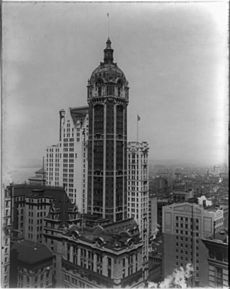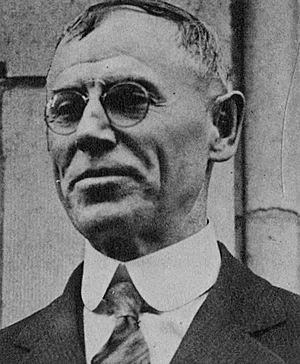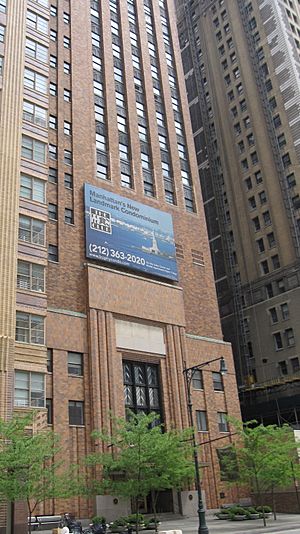Downtown Athletic Club facts for kids
Quick facts for kids Downtown Club |
|
|---|---|

The eastern facade of the Downtown Club (left) and 21 West Street (right)
|
|
| General information | |
| Type | Residential |
| Architectural style | Art Deco |
| Location | 20 West Street, New York, NY 10004 |
| Coordinates | 40°42′22″N 74°00′56″W / 40.70611°N 74.01556°W |
| Construction started | 1929 |
| Completed | 1930 |
| Height | |
| Roof | 518 ft (158 m) |
| Top floor | 515 ft (157 m) |
| Technical details | |
| Floor count | 35 (+4 attic) |
| Design and construction | |
| Architect | Starrett & van Vleck |
| Designated: | November 14, 2000 |
| Reference #: | 2075 |
The Downtown Athletic Club, also known as the Downtown Club, was a special club in New York City. It was located at 20 West Street in Lower Manhattan's Financial District. This club was famous for giving out the Heisman Trophy. This award goes to the best college football player each year. It was named after John Heisman, who was the club's first sports director.
The club started in 1926 for men only. They bought land for their building in 1927 and finished building it in 1930. The club faced money problems and sold the building in 1936, but got it back in 1950. In 1977, women were allowed to join the club. After more money troubles in the late 1990s, the club sold part of its building.
The club closed after the September 11 attacks in 2001. The building was near the World Trade Center. The area around the club was blocked off, so people could not get to it. This made the club lose money and it had to close. The building was later changed into a residential building with apartments.
The 35-story Downtown Athletic Club building was designed in the Art Deco style. The architects were Starrett & van Vleck. They also designed the building next door, 21 West Street, at the same time. The club building had many sports areas, plus places to live and eat. It was made a city landmark in 2000.
Contents
Where Was the Downtown Club Located?
The Downtown Club building is located at the very bottom of Manhattan Island. It is close to the water on the west side. The building faces West Street on one side and Washington Street on the other. Its main address is 20 West Street.
The building stands on land that was once water. This land was filled in during the 18th and 19th centuries. This happened as New York City grew bigger. The land where the club stands was filled in 1835. This was done using dirt and rubble from a big fire in New York.
What Does the Downtown Club Building Look Like?
The Downtown Club building was designed in the Art Deco style. This style was popular in the 1920s and 1930s. It often uses geometric shapes and rich decorations. The architects, Starrett & van Vleck, also designed the building next to it, 21 West Street. Even though they were built at the same time, the Downtown Athletic Club building looks a bit darker. It is about 518 feet (158 m) tall, which is like a 50-story building!
The building was planned so that different floors had different uses. The lower floors were for sports. The upper floors had bedrooms for members.
Building Shape and Setbacks
The Downtown Club building takes up the whole block between West and Washington Streets. It is the tallest building on that block.
The building has "setbacks." These are parts of the building that step back from the street as it goes higher. This was a rule in New York City to let more sunlight reach the streets below. The lower floors were the largest. The sports floors (4th to 19th stories) were set back. The hotel rooms (above the 26th story) also had a setback.
Outside Look (Facade)
The outside of the Downtown Athletic Club building is made of orange bricks with patterns. This gives it a cool texture. The color is different from the building next door. The bricks are used in special ways around the windows and the roof.
The design of the outside also shows what was inside. The hotel rooms on the upper floors had smaller windows. The sports floors (4th to 19th stories) had larger windows. Some areas, like the squash courts, did not need windows at all.
Base of the Building
The bottom four floors are called the base. The main entrance is on West Street. It has three brick columns and metal doors. Above the doors is a metal cover and a big window with cool chevron patterns.
The Washington Street entrance is simpler. It also has metal doors and a metal cover.
Upper Floors (Tower)
Above the fourth floor, the building steps back on both West and Washington Streets. The windows change as you go up. Some floors have many windows, while others have fewer or even none where sports courts were. There are more setbacks higher up, like on the 16th, 17th, and 26th floors.
The very top floor (35th story) has a brick band and special patterns above the windows. There is also a three-story tower on the roof with decorative bricks.
What Was Inside the Downtown Club?
The lower floors of the club were mostly for fun and sports.
- The ground floor had the lobby and offices. The lobby sometimes showed the Heisman Trophy.
- The third floor had billiard tables and card rooms.
- The fifth floor had bowling alleys.
- The fourth and sixth floors had courts for racquetball, handball, tennis, and squash.
- The seventh floor had a miniature golf course.
- The eighth floor had a gym.
- The twelfth floor had a swimming pool. It was said to be the highest pool in the world when it was built!
- The 10th floor had medical rooms.
- The 13th to 19th floors had dining rooms and lounges.
The 20th to 32nd floors had 143 private hotel rooms. Famous people stayed in these rooms, like boxer Muhammad Ali, baseball players Joe DiMaggio and Mickey Mantle, and comedian Bob Hope. Many Heisman Trophy winners also stayed there.
The top three stories held water tanks and other equipment. The building also had six passenger elevators and one freight elevator.
The inside of the club was designed with "unusual lighting" and cool patterns. It was praised for its amazing Art Deco style.
History of the Downtown Athletic Club
How the Club Started

The Downtown Athletic Club was started on September 10, 1926. A group of lawyers led by Schuyler Van Vechten Hoffman created it. For 51 years, it was only for men. The club was for businessmen and other office workers in Lower Manhattan. At first, it was in the Singer Building on Broadway.
Soon, the club wanted its own building. They looked at other sports clubs to decide what to include. In 1927, they bought land on West Street. They planned to build a 20-story building.
By 1928, the club had 1,000 members. They announced plans for a new clubhouse. The architects, Starrett & van Vleck, were chosen. Because there wasn't much space in Lower Manhattan, the clubhouse had to be a skyscraper. The project was expected to cost $4.5 million. The plans changed a few times, from 44 stories to 17, and then to 38 stories.
By mid-1930, the building was almost finished. The new clubhouse opened in September 1930. The club had 3,826 members then. The building ended up having 35 stories.
Club Operations and Challenges

John Heisman became the club's first sports director in 1930. He started a "touchdown club" there, which became very popular. In 1935, a club member suggested giving an award to the best college football player. The first award was given that year. When Heisman passed away in 1936, the award was renamed the Heisman Trophy in his honor.
The club needed at least 5,000 members to make enough money. Many members worked in finance or law. After the Wall Street Crash of 1929, many people could not afford the membership anymore. The club faced serious money problems and declared bankruptcy in 1936. They owed a lot of money in taxes. The building was sold in 1947, but the club bought it back in 1950.
Over the years, some changes were made to the building. A bar was added, and the dining room was made bigger. Some original features, like the golf course, were removed. The club had the most members in the 1960s, with 4,500 people. In 1977, the club voted to allow women to become members. This was mainly to help with their money problems.
The Club's End
By 1998, the club had fewer than 1,300 members and the building was "crumbling." The club owed $3 million in back taxes. They talked about selling the top floors to developers. The New York City Landmarks Preservation Commission wanted to protect the building's outside look. In 1999, the club made a deal to stay in its building and get out of bankruptcy. They planned to keep the lower floors for the club and turn the upper floors into a hotel. The building became an official city landmark in 2000.
The Downtown Athletic Club closed for good after the September 11 attacks in 2001. The building was very close to the World Trade Center, which was destroyed. The club building itself was not damaged. However, the area was blocked off, so no one could get to the building for a long time. This caused the club to lose a lot of money. The building also started to get damaged from being empty.
By late 2001, the club hoped to reopen. But they owed $8.3 million and needed much more money for repairs. Few members could help, and the club was losing $100,000 every month. The Downtown Athletic Club could not pay its debts. In 2003, the club gave up the building and left completely.
What Happened to the Building After?
The building was changed into a residential tower called the "Downtown Club." It opened in 2005. It now has 288 apartments. Most of these are studio or one-bedroom apartments. The building also has a large fitness center, a lounge with a pool table, and an outdoor terrace. A preschool was also opened on the ground floor.
The Famous Heisman Trophy
The Downtown Athletic Club used to give out the Heisman Trophy. This award honors the best player in National Collegiate Athletic Association college football each year. The Heisman Trophy was first given in 1935. It was later renamed after John Heisman, the club's first sports director.
The trophy itself is made of cast bronze. It is about 13.5 inches (340 mm) tall and weighs 45 pounds (20 kg).
After the Downtown Club closed because of the September 11 attacks, the Heisman Trophy ceremony moved to different places. It was held at the Yale Club of New York City and the Hilton New York. Since 2005, it has been held at the Palladium Times Square. The Heisman Trust now gives out the trophy.
See also
 In Spanish: Downtown Athletic Club para niños
In Spanish: Downtown Athletic Club para niños
- Art Deco architecture of New York City
- List of New York City Designated Landmarks in Manhattan below 14th Street


